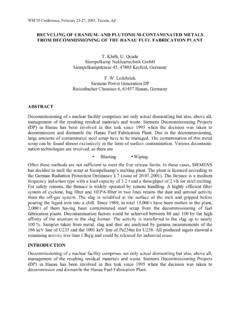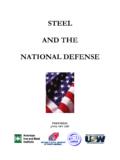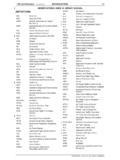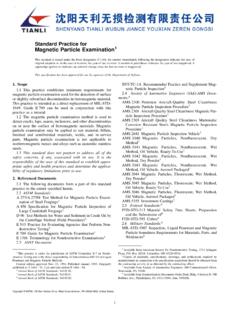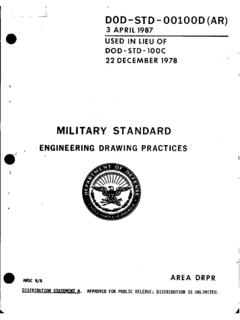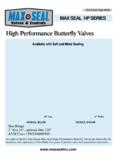Transcription of A NOVEL APPROACH TO DRUM VENTING AND …
1 WM'03 Conference, February 23-27, 2003, Tucson, AZ. A NOVEL APPROACH TO drum VENTING AND drum monitoring . Ohl, Farwick, Douglas, Cruz Vista Engineering Technologies, LLC. 8203 West Quinault Avenue, Building C, Suite 200, Kennewick, WA 99336. ABSTRACT. This paper describes the details and specifications associated with drum VENTING and drum monitoring technologies, and discusses the maturity of in-place systems and current applications. Each year, unventilated drums pressurize and develop bulges and/or breaches that can result in potentially hazardous explosions, posing undesirable hazards to workers and the environment. drum VENTING is accomplished by the safe and simple installation of ventilated lids at the time of packaging, or by the inherently risky in-situ ventilation (depressurization) of bulged drums. drum monitoring employs either a Magnetically Coupled Pressure Gauge (MCPG) Patent Pending and/or a Magnetically Coupled Corrosion Gauge (MCCG) Patent Pending.
2 Through patented magnetic sensor coupling, these devices enable the noninvasive and remote monitoring of the potentially hazardous materials and/or spent nuclear fuel that is contained in 55-gal drums and associated steel overpack containers. INTRODUCTION. drum VENTING Background The Hanford Site is one of the Department of Energy sites that generate and/or store the transuranic (TRU) wastes associated with national defense programs. In 1970, the Atomic Energy Commission defined TRU waste as a separate waste category and mandated storage in retrievable, contamination-free packages designed to last 20 years. Since 1970, approximately 37,400 suspect-TRU and TRU waste containers have been placed in retrievable storage in the Low Level Burial Ground (LLBG) at the Hanford Site [1]. TRU drums are visually checked for structural integrity, and placed in overpack containers, as needed, during the retrieval phase. Drums containing TRU material are vented, if necessary, and transported from the LLBG to a Treatment, Storage, or Disposal (TSD) facility, where they are stored for certification activities that support disposal at the Waste Isolation Pilot Plant (WIPP) in New Mexico.
3 In addition to checking structural integrity during the retrieval inspection, drums are checked specifically for VENTING devices. drum VENTING is necessary because radiolysis of plastics and cellulosic materials in the waste matrix of TRU waste packages generate hydrogen gas, creating potential flammability hazards inside unvented drums. Over time, it is possible that the hydrogen-oxygen atmosphere can reach concentrations that pose fire or explosion hazards. Hydrogen levels as high as 27 percent (lower explosive limit is 4 percent) have been encountered in retrieved TRU drums at Los Alamos National Laboratory, LANL [2]. VENTING over- pressurized TRU waste drums that contain elevated levels of hydrogen or other flammable gases could result in severe worker injury or death from the impact of a drum lid ejected as a result of internal deflagration inside the waste drum . Vista Engineering Technologies, LLC Page 1. WM'03 Conference, February 23-27, 2003, Tucson, AZ.
4 In 1978, the Hanford Vent Clip was installed on TRU waste drums originating from Hanford. This clip is an inch wide strip of stainless steel that was placed between the rim of the drum and the mating drum lid. Upon tightening of the lid hold-down ring, a complete seal was prevented, because the clip protruded approximately below the ring. Nonetheless, not all TRU. drums containing the Hanford Vent Clip have maintained adequate ventilation and/or the visible portion of the vent clip has been destroyed during storage. VENTING of retrieved TRU drums at the Idaho National Engineering and Environmental Laboratory (INEEL), LANL, and the Savannah River Site (SRS) has been successfully accomplished, by utilizing a drum VENTING System (DVS) that involves drilling a hole in the container lid with a spark resistant titanium nitride drill bit, followed by the installation of a Nucfil filter or equivalent. To support the drilling of the lid, the DVS requires a complex system involving an ASME certified containment vessel, a glove box, the drilling mechanism, a HEPA filter system, and VENTING and sampling equipment.
5 Though successful, this procedure is nevertheless quite cumbersome. The Hanford drum VENTING System (H-DVS) Patent Pending was conceptually developed for the in-situ VENTING or depressurization of TRU waste drums at the Hanford Site. The system involves the integrated use of a properly ventilated portable containment with expansion bellows, a simple mechanical advantage system, and a pneumatic ram. The system allows operators to safely install environmentally compliant drum ventilation in the field on existing or newly discovered drums. The system is easily deployable and adds incrementally small costs to the total cost of modest environmental remediation projects that involve repackaging of drums. drum monitoring Background Department of Energy (DOE) guidelines DOE G , Section L. specifies: Vents or other mechanisms to prevent pressurization of containers or generation of flammable or explosive concentrations of gases shall be installed on containers of newly-generated waste at the time the waste is packaged.
6 Containers of currently stored waste shall meet this requirement as soon as practical unless analyses demonstrate that the waste can otherwise be managed safely.. The Environmental Protection Agency (EPA) assurance requirements regarding the disposal of spent nuclear fuel and TRU (40 CFR ) specify: Disposal systems monitoring shall be done with techniques that do not jeopardize the isolation of the wastes and shall be conducted until there are no significant concerns to be addressed by further monitoring .. The above regulations address two concerns - container integrity and noninvasive monitoring . In 1998, Vista Engineering Technologies (Vista Engineering) personnel conceived of a NOVEL means to measure pressure in a totally sealed steel container. The concept initially exploited the fact that stainless steel containers are virtually transparent to magnetic fields, which allows the rotation angle of a magnet needle to be measured outside the container and with no penetrations of the container, with an accuracy approximating 2 to 3 percent of full-scale.
7 Vista Engineering Technologies, LLC Page 2. WM'03 Conference, February 23-27, 2003, Tucson, AZ. Subsequent development has found that, although attenuation drops off dramatically, a magnetic signal can readily be detected through carbon steel barriers ( , 55-gallon drum lids) as well. This device, the Magnetically Coupled Pressure Gauge (MCPG) Patent Pending, requires no internal or external power supply, is resistant to radiation effects, and has an expected lifetime of more than 50 years. Vista Engineering has fabricated and delivered over 500 of these gauges to the Department of Energy for use by Hanford's Spent Nuclear Fuel (SNF) Program and Plutonium Finishing Plant (PFP) for monitoring containers storing nuclear materials. Magnetically coupled gauges can also see through carbon steel, provided that the magnetic permeability is uniform throughout. The MCPG solved the pressure-measurement problem. By a simple extension of the well- proven MCPG technology, Vista Engineering has prepared a conceptual design for a Magnetically Coupled Corrosion Gauge (MCCG) Patent Pending.
8 The MCCG is simple to fabricate, robust to withstand the shipping environment, made entirely of 316/304 stainless steel, and like the MCPG, is easily installed in the 3013 Bagless Transfer Convenience Can (BTCC). The current design provides for six (6) independent coupons. drum VENTING DISCUSSION. Preliminary Design Requirements of the CVS. Based upon the TRU retrieval safety analysis, any Container VENTING System (CVS) used at the Hanford Site has been identified as significant to worker safety [2]. As previously stated, VENTING TRU waste drums that are over-pressurized, or contain elevated levels of hydrogen or other flammable gases, can result in severe worker injury or death from an impact by an ejected drum lid caused by an internal deflagration inside the waste drum . The safety function of the CVS is to shield workers from missiles ejected from the waste drum during VENTING and filter installation activities. Therefore, the functional requirement related to the CVS role in the hazards analysis is to mitigate the worker consequences of potential hazards associated with VENTING TRU waste drums that are over-pressurized or contain elevated levels of hydrogen gas.
9 The CVS meets its functional and safety requirements, when it provides a contained and automated environment for the drilling and VENTING operations, thereby eliminating the manual performance of such activities by workers. Preliminary design requirements and goals are outlined in Tables I and II. below. Table I. Preliminary Design Requirements No. Preliminary Design Requirement 1 Ventilate drums having >50 psi internal pressure 2 Eliminate spark sources during ventilation 3 Install passive filtration for long term ventilation 4 Engineered barrier to missiles Vista Engineering Technologies, LLC Page 3. WM'03 Conference, February 23-27, 2003, Tucson, AZ. Table II. Preliminary Design Goals No. Preliminary Design Goal 1 Maximum time allowed for filtration is 15 minutes 2 System is operated by two nuclear process officers ( no specialized technicians). 3 Simple, robust, system 4 Operated at retrieval site 5 Return on Investment > 200% over 5 years Proposed CVS Solution: The Hanford drum VENTING System (H-DVS).
10 An engineered solution, called the Hanford drum VENTING System (H-DVS) Patent Pending, has been developed for in-field VENTING of retrieved drums from long term storage in burial trenches. Vista Engineering has developed a pre-conceptual design that utilizes pneumatic rams to install air filters in a manner not harmful to the health and safety of site workers. The drum and contents are not expected to present a possible on or off-site dose above limits that would require Safety Class or Safety Significant features. However, possible reactions with flammable drum gases could yield sufficient explosive energy to launch drum heads that could seriously injure facility workers. The principle mechanism for housing required filter installation equipment is revealed in Figure 1 below. Figure 1. Preliminary design concept of H-DVS. The drum head restraint will likely be Safety Significant due to the possibility of serious injury to the worker. The proposed shroud and passive filter will provide a partial mitigation of any released alpha contamination during the VENTING and any upset sequences that occur during the VENTING .

